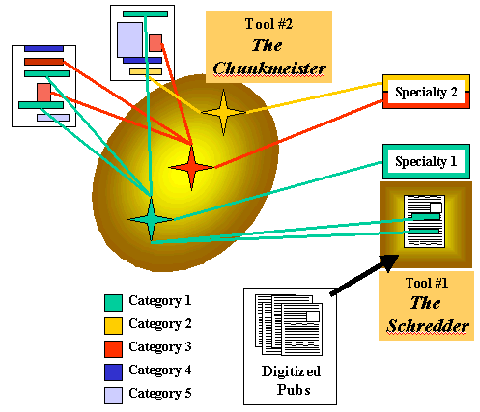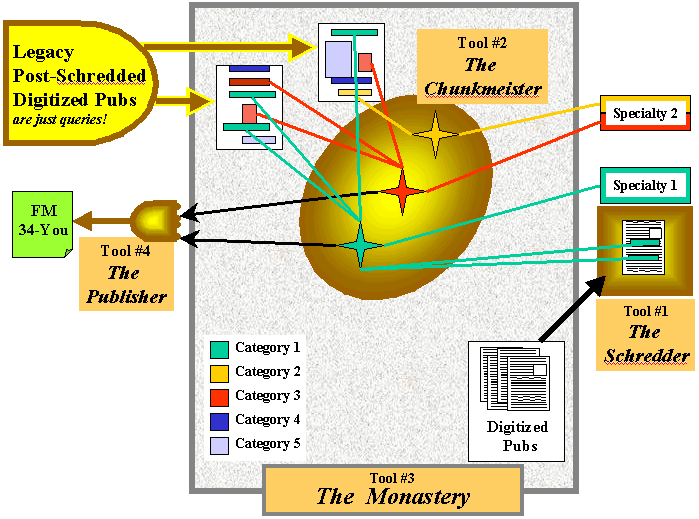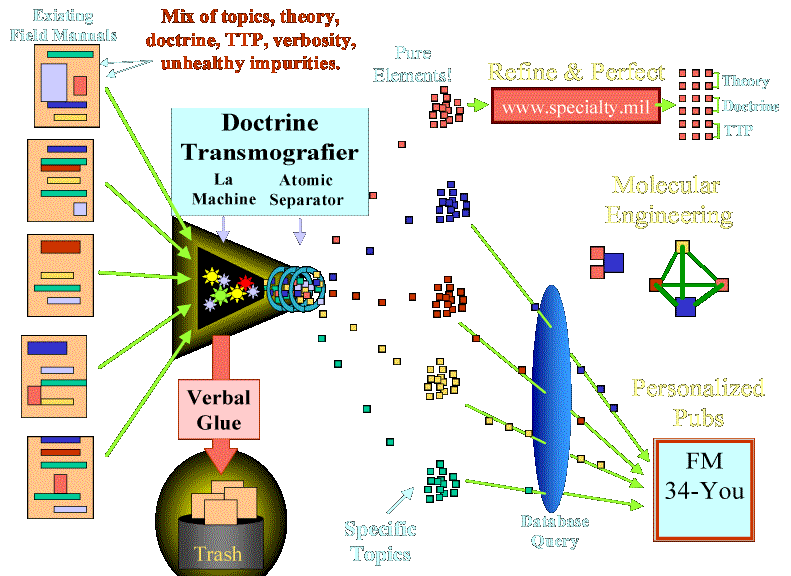|
Doctrine currently exists as a series of Publications.
They are each written by different people, at different times.
Creation and publication is exhaustive, and dictated by available
resources. Although some
publications should be derived from others, this is seldom the case
as the logical sequence seldom matches the funded publication sequence.
Our current doctrinal production system is state-of-the-art... for
the year 1750. This is not
an indictment of the Intelligence Center's doctrinal division, they must
work within the archaic rules and meager funding given them by the
Training & Doctrine Command. Here is a simple 12-step method to fix the process... simple because it is technically feasible, inexpensive to implement, builds on the strengths of the Information Age, and enables the entire Intelligence community to become involved in continuous improvement of our professional knowledge.
|
|
| 1. | Convert
existing publications to digital text.
|
| 2. | Develop
initial set of Intelligence Categories for text chunks.
Develop sub-categories as needed. An example
of a categorization system is the one used in The S2 Company File
Cache.
|
| 3. | Build
Tool 1: The Schredder.
This is a software tool that allows a user to highlight
digital text with a unique color that represents an Intelligence
Category. The act of
highlighting links that text to the category within an ODBC database
(ODBC means "Other Data Base Connectivity" and is a common
format that many popular data bases can read) . A passage of text can have more than one color highlight, and
can therefore belong to more than one category.
- Different users can highlight a passage of text differently, and the database will track who highlighted what, and at what date/time. - Users can further assign a subcategory to the text passage, or different sub-categories to different parts of the same passage. - Users can insert their own comments and notes that remain linked to a specific passage. - Users can link external objects (diagrams, video, audio, etc) to a specific passage. - Users can link one categorized / subcategorized passage to another, and attach notes or objects to that link. - Users can see everything done by other users, but cannot change what others have done.
|
| 4. | Build
Tool 2: The Chunkmeister.
This is the database that supports The
Schredder. It
must be able to support all that was described above. It must also be user-configurable, so that the user –
particularly the advanced user – can create database tools to enhance
his performance. The advanced user must be able to create
new input forms, tables, queries, output forms, macros, and scripts that
all run within the security parameters of the database. Users must
be able to save these enhancements in a way that would allow other users
to see them, use them, copy them and modify the copy into a new tool.
|
| 5. | Build
Tool 3: The
Monastery. |
|
In addition to the tools themselves, there must be a library for the storage, annotation, and dissemination of user-created tools and enhancement. There must be a discussion area for users to chat asynchronously, for instance, via a threaded discussion forum. Essentially, The Monastery must be more than just a way to connect the tools, it must be a community focused on the task of doctrinal production.
|
|
| 6. | Users
begin to use the above tools to parse existing manuals down into Categorical
Chunks. Periodically there can be forums focused on resolving conceptual differences. The actual result of these -ie decisions rendered- will not be as important as the fact that there was a discussion, that many participated, that many views were presented, and that the entire discussion becomes a part of the database for future reference.
|
| 7. | Categorical
Chunks are assigned to Specialty
Communities for further refinement.
Specialty Communities are web-based communities of intelligence
professionals sharing a common specialty. The specialty may or
may not directly correspond to a specific MOS, but rather reflects a
logical grouping of skills and competencies. Examples of
existing informal communities are Link
33, the Ranger
Association, Company
Command.Com, and, of course, The
S2 Company!
The formal creation and development of Specialty
Communities is essential, but not a result of this initiative.
Until they appear, work is done from The Monastery.
|
| 8. | Specialty
Users label the chunks within their category as Theory, Doctrine, or TTP.
a. Theory is the body of fundamental knowledge based on the study
of warfare. It is derived
from the community specializing in that field of study. An example of Theory is the four-step Intelligence
Cycle (Direct, Collect, Produce, Disseminate), a direct derivative of
the Scientific Method. Theory
itself evolves slowly, advanced by the experts in that field.
b. Doctrine is a subset of Theory that has been adopted by
leadership, usually after some changes.
Doctrine changes at the whim of leadership, usually to reflect
the US Army’s adopted style of warfighting.
An example is the doctrinal adaptation of the Intelligence Cycle
that breaks “Disseminate” into “Disseminate and Present”,
reflecting the importance of tailoring output to a commander’s needs. c. Tactics/Techniques/Procedures (TTP) is the application of Theory or Doctrine to a situation. TTP are created by users. TTP derived from non-Doctrinal Theory are generally considered unacceptable; however, if they work well they often cause the doctrine to change to embrace the previously unacceptable Theory. TTP derived from Doctrinal Theory can also become doctrine if adopted as such. An example of this was the addition of a “Processing” step between “Collection” and “Production”, reflecting the need to modify (“process”) collected data so that the Analyst could use it to Produce Intelligence. Eventually this found it’s way into Doctrine
|
| 9. | Specialty
Users refine and perfect the contents of their assigned Categories.
They conduct internal debates, and continuously present their findings
to the rest of the Intelligence Community via their web site, magazine
article, and presentations at public forums such as the Army Worldwide
Intelligence Conference.
|
| 10. | Specialty
Users identify which of their Categorical
Chunks are: 1) Linked
to the Categorical Chunks
owned by other Specialties; 2) Could be claimed by another specialty because of functional
overlap; 3)
Should be linked to another Specialty.
The collaborative tools within The
Monastery facilitate this identification and resolution.
Identifying these links and establishing a high degree of specificity is critical to the function of Intelligence on the battlefield.
|
| 11. | Specialty Users create Learning Gizmos. These
include highly detailed 3-D virtual reality collaborative worlds, video
and audio clips, slide shows, pictures, drawings, job aides, lesson
plans, and Frequently Asked Questions (FAQ) lists.
Learning Gizmos will
be built by the Specialty Subject Matter Experts, using
commercially available software tools.
There must NOT be a central production facility!
The Distance Learning
Office becomes a Learning
Gizmo Skunk Works: finding state-of-the-art creation tools, testing
these tools, writing reviews, and hosting discussions and lessons
learned. Specialty
Communities determine which tool is best for constructing a desired Learning
Gizmo, and buys it. Specialty
Communities use the Web as a projection platform to disseminate what
they create. Their target
audience consists of members of their Specialty and others who depend on
their Specialty: dependence is
determined by the pre-determined links
between Categorical Chunks.
Each Learning Gizmo is
linked to the appropriate Categorical
Chunk via The Chunkmeister.
A Learning Gizmo can also be linked to THE
LINK between two Categorical
Chunks.
|
| 12. | Build
Tool 4: The
Publisher. The Publisher
allows soldiers to construct a Personal
Publication (ie that FM 34-YOU everyone always
accused you of using!) by formulating a query across all specialties.
He includes those Categorical Chunks and Learning
Gizmos appropriate to his needs.
The Publisher will
enable him to organize the results of his query into whatever format is
desired. The
Publisher facilitates the soldier inserting his own text or Learning
Gizmos to further personalize the result.
The soldier has the option of uploading his entire Personal
Publication – to include his added text and Learning
Gizmos – to his Specialty
Site or to The Monastery
for others to use. Since
his Personal Publication is mostly a query, it will be rather small in
size… and always up-to-date. The
Publisher must also facilitate the actual generation of the Personal
Publication as a stand-alone document: extracting the contents of
the Categorical Chunks and assembling them into the specified format.
The soldier has the option of saving this to disk, creating a
customized CD, or printing it out. The Publisher is a
download from The Monastery. What we currently refer to as “Doctrinal Publications” will cease to exist. In their place will be a series of queries, created using The Publisher, that will essentially reassemble the ancient, legacy publication. |


